 |
 |
Dance Festival
of India at Carnegie Hall, New York
October 20,
2008
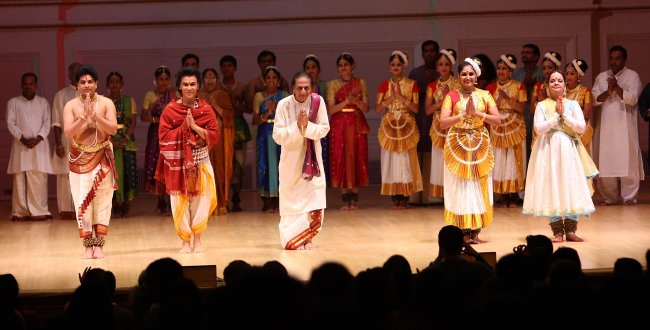 The ARCH Inc is a consortium of organizations operating as a single 501 © (3) non profit organization, registered in 1999, that works to make a difference in the community primarily through creativity-based and multi-cultural education. They have successfully presented dancers and musicians and have a studio space in Manhattan where classes in Bharatanatyam, Odissi and Kathak are run by leading dancers based in New York and music classes by musicians of Academy of Music, who under the guidance of Sangeet Research Academy, Kolkata’s musician vocalist Dr Vijay Kichlu have music courses offered to music lovers. The ARCH Inc is a meeting place for artists, musicians, dancers and people interested in creative arts.
His company consisting of himself, the star pupil January Low, inimitable Guna, and other experienced and young dancers Rathimala, Geethika, Divya and Michelle, a confluence of Malaysian Muslim, Hindu, Chinese, immigrants from India, now settled in Malaysia, performing with élan India's neo- classical dance form Odissi, with Siva Natarajah, a vastly gifted painter, photographer and lights- designer who with his arresting lighting creates the mystic and literally keeps the audiences ‘spellbound’! They performed
within 30 minutes two dance numbers: Managlacharan and Aditya Archana.
The vast sprawling Isaac Stern Auditorium/Roland O Perelman stage of Carnegie
Hall was transformed into a sacred space, the moment the dancers entered
the stage offering prayer in praise of Goddess Saraswati. Narrating her
as one dressed in white and colourful costumes, bejeweled with silver ornaments,
the dancers with their flawless movements and joyous abundance captivated
the audience. Late Guru Deba Prasad’s style has been imbibed by Ramli in
an admirable manner. The solo number has been choreographed as a group
dance. The energy that the dancers exude has to be seen to be believed.
A characteristic of Ramli's approach with dancers forming a circle, moving
on the stage, energizes the space. There is a forward and backward movement,
and formations which amaze onlookers, the patterns that invest themselves
with novelty, the iconographic poses, reinventing in a sculpturesque mould,
bring those visuals alive- a sheer delight to feast one’s eyes on them!
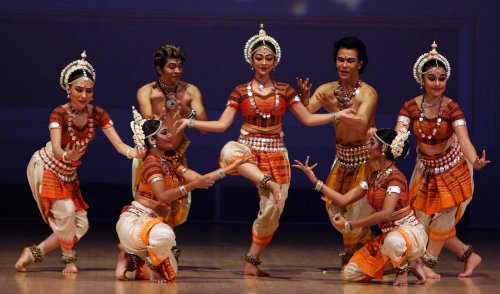 The program note says the following: “From ancient times, Surya has always been the object of worship. Emerging from the primordial waters, he sits on a lotus in his golden chariot, drawn by seven horses, representing the seven colours and driven by his charioteer Arun. Surya, the Sun, is not only regarded as the source of light and knowledge but also that of the world. Thus he is known as Aditya. The hymn to Surya expresses some of the highest emotions, alluding to the wonder of our existence. Surya is the maker of the day, the dispeller of darkness, the nourisher, the eye of the world, the witness of deeds, the King of planets, the one having a thousand rays. Most of all, he is Mahapapahara, the one who is able to remove delusion, misfortune and flawed thinking, thus bringing his devotee to liberation.” 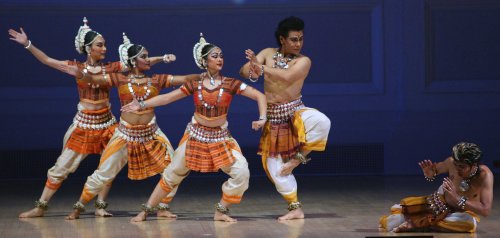 C V Chandrasekhar, were exquisite. The bending of the dancers in yogic position, the offerings to Surya, lifting the female dancer raising her as it were to heaven et al were evocative and picturesque. If the presentation appealed to most of the people and there was a general feeling that Odissi and Kathak dance forms were the best, it is understandable. Not because Bharatanatyam's appeal is less or Kuchipudi was not at its best. CV Chandrasekhar's three Bharatanatyam choreographic pieces were of the highest order, and so were Vempati Chinna Satyam’s choreographic pieces. In Kuchipudi, the dancers Prabha Ramesh, Geeta Madhuri, Kalpana, Vempati Ravi, DSV Sastry and Venkatachalapathy, accompanied by the musician Kantilal, Murali, Neeladri, DVN Murthy and Sudhakar were in their element and showed off Kuchipudi at its best. Whether it was Brahmanjali or a tillana, they displayed Vempati's bani (style) to an advantage. There was robust acting in Ksheersagara Shayana, a kriti of Thyagaraja, in the episode of Draupadi Vastrapaharan, when Venkatachalapathy, son of late Vedantam Rattaiyya Sarma acted as Duryodhana, and one saw literally the wickedness personified in Vempati Ravi's abhinaya as Duhssashana. 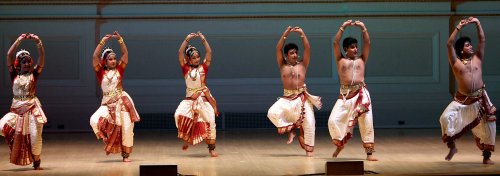 The troupes of CV Chandrasekhar and Vempati Chinna Satyam were supported by Indian Council for Cultural Relations. Disciple of
Dr. Kanak Rele from Nalanda Mahavidyalaya, Mumbai, Sunanda has after migrating
to Texas maintained the high standard of Mohiniattam as revived by Kanak
Rele. Sandwiched between the Odissi and Kuchipudi, it did suffer in comparison.
At the same time, it revealed the beauty of the form different from mistaken
notion that it is a poor cousin of Bharatanatyam.
C V Chandrasekhar's choreographic pieces with which the festival opened were well crafted and imaginatively choreographed in Bharatanatyam revealing the architectonic beauty of the form by well trained dancers of Nrityashree Dance Company from Chennai. A versatile performer and a choreographer with vast experience, musical acumen and minus a flamboyant attitude, replete with dignity and ‘auchitya,’ Chandrasekhar's presentation was most appropriate as an opening of the festival. 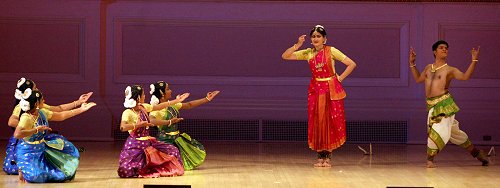 The idea of Siva as the supreme dancer Nataraja is a cherished expression in the visual and performing arts in India. The piece recreated the beauty and grandeur of Siva's dance as experienced by the mortals and celestials. The concept mirrored in the poetry describing how the Lord’s hands swayed and created patterns in space, and how the eyes followed the hands. As his feet moved, the rhythm with Lord Shiva's ankle bells created music. The piece was set in raga Durga. The dancers performed it with exquisite movements, arresting groupings and they covered the stage with ease filling the space with visuals enhancing the impact a form like Bharatanatyam invariably creates. In Ecstasy, the tillana found a joyous exposition of the very aesthetics of Bharatanatyam. Complex rhythmic structures in dance were woven through wefts of melody. The final texture was magical. The tillana was set in the raga Simhendramadhyama. The dancers at times sat on the floor and played the cymbals and joined other dancers, exploring different levels while dancing. The dancers including three male dancers and female dancers consisted of Chandrasekhar's two daughters Chitra Dasarathy and Manjari, Ashwini, Krishna Chidambaram, Nirmala, Krishna Kumar, Praveen, Shaffik and musicians on mridangam Adyar Balu and Devaraj. C V Chandrasekhar and his wife Jaya Chandrasekhar conducted the nattuvangam. 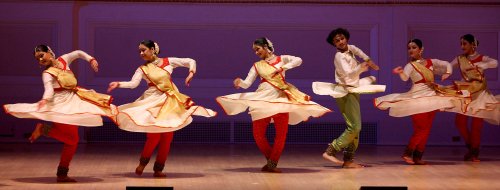
Six youthful young female dancers and two male dancers brought down the house. Titled Sampada, a treasure, by choreographer Prerana Shrimali, it revealed various traditional infrastructures incorporating them in an over-all design, giving glimpses of the many splendoured beauty of Kathak- the chaal, the gats, the tihais, the footwork, tatkar, the rhythmic wizardry, to the exquisite tabla and pakhavaj playing by two brothers Fatehsingh and Yogesh Gangani, worthy sons of late Kundanlal Gangani, further enhanced by the melodious notes on sarangi by the wizard sarangi player Ramesh Mishra. The finale kept the audience on the edge of their seats. And the rousing standing ovation they got was indicative of the power the Kathak dance form exercised, keeping the audience hungry- not giving more, but with restrain, they left them wanting to see more of their dance. The dancers were two male dancers Mulla Asaraf and Mahendra Parihar, and the female dancers were choreographer Prerana Shrimali, Vidha Lal, Pratishtha, Shailaja Nalawade, Pragati Sood and Eisha Aggarwal. A memorable evening. The like of which is a rare event in New York. Many summers ago Beate Gordon, Director of the Performing Arts program of Asia Society used to present year after year, Indian classical dance forms at Carnegie Hall, at times group dances, at times solo dances by the likes of Birju Maharaj, Sitara Devi, Yamini Krishnamurty, and group dances like dances of Purulia Chhau and Yakshagana dances. Those halcyon days are a matter of the past as are the days of Festival of India in USA. The well- informed critics are also no more in New York; many have been retired and the new ones have no clue as to what classical dance forms are like. With a staggering variety of dance forms of the world presented in New York, the critics have a difficult task to undertake to do justice to the traditional dance forms of India.
To bring 60 dancers, and musicians accompanying the dancers from different parts of India and Malaysia, was a Herculean task. But the organizers succeeded against all odds. Linking the dance forms as a host and a commentator was none other than Anita Ratnam, the celebrated Bharatanatyam dancer, director of The Other Festival in Chennai, charting her own path in what she calls Neo -Bharatam and whose brainwave is the fantastic e-journal Narthaki.com, a brilliant orator, a speaker, a seasoned commentator and a 'pucca' New Yorker - she divides her time between Chennai and New York (she is global, she mentions). She was in her element. Her commentary in absence of the program notes was excellent as she made it simple, comprehensible and enjoyable. With stunning stage presence she charmed away the audience who was willing "to eat out of her hands." Bravo, Anita!! In terms of
feedback one received several comments to the effect that there should
have been more than one evening presentation. Doubtless the event has generated
an excitement for classical dance forms by artistes, practitioners from
India who have made their mark on the international scene.
|